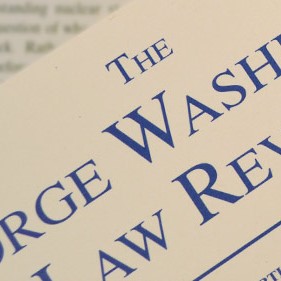Todd David Peterson · November 2010
79 GEO. WASH. L. REV. 101 (2010)
Over the course of a thirteen-year period from 1977 to 1990, the Supreme Court decided thirteen major cases on the issue of personal jurisdiction. This outpouring of opinions generated a burst of scholarly interest in the subject of personal jurisdiction and a raft of articles highly critical of the Court’s inability to enunciate a coherent theory of precisely why the Due Process Clause imposes limitations on the states’ exercises of personal jurisdiction. In all the years since 1990, the Supreme Court has not returned to the subject of personal jurisdiction and has left the lower courts on their own to try to make sense of a doctrine without any clear foundation. That has not, however, deterred scholars, some of whom have bravely ventured to bring order to chaos and provide a theory about how the Due Process Clause relates to limits on personal jurisdiction, and others of whom have struggled to address how personal jurisdiction doctrine is affected by changes in technology like the development of the Internet. The Supreme Court has left much room for scholars to explore what the connection between due process and personal jurisdiction is all about.
This Article approaches the issue differently, following the lead of Stephen Jay Gould, who for years wrote about important issues of science by looking at small and seemingly insignificant parts of the natural world and drawing from them lessons about much larger issues like the theory of evolution. This Article takes a similar approach by analyzing the relatively small and oft-overlooked constitutional issue of the timing of minimum contacts, that is, the relevant time period during which a defendant’s contacts with the forum state may subject it to personal jurisdiction within that state on a particular lawsuit. Under the modern doctrine of personal jurisdiction law, the Supreme Court has required that a defendant have certain “minimum contacts” with the forum state that make it permissible for the state to enter a binding judgment against that defendant. If the defendant’s contacts with the forum state are sufficiently continuous and systematic, the state may exercise general jurisdiction over any claim against the defendant, regardless of where it arose. If the defendant’s contacts with the forum state are isolated and sporadic, the state may exercise specific jurisdiction over only those claims that arise out of the defendant’s contacts with the forum state. In each type of case, a court may have to determine the time period during which contacts are relevant to the determination of whether the court may exercise personal jurisdiction. For example, in both general jurisdiction and specific jurisdiction cases, a court may have to decide whether the required contacts must exist at the time the claim arose, at the time the lawsuit was filed, or at the time the court is asked to determine whether it has personal jurisdiction.
The Supreme Court has given very little guidance to help the lower courts decide these issues. The Court has never directly addressed the issue of the timing of minimum contacts in any of its personal jurisdiction decisions. More importantly, from 1877, when the Court first announced in Pennoyer v. Neff that the limitations on personal jurisdiction that had previously been a product of federal common law were thenceforth required as a matter of due process, up through the Court’s most recent case on the matter, the Court has failed to enunciate a clear rationale for why the Due Process Clause imposes any limitations on the exercise of personal jurisdiction.
This Article considers the issues discussed above in three Parts. In Part I, the Article takes a brief look at the minimum contacts standard and the Supreme Court caselaw governing both general and specific jurisdiction. In Part II, the Article analyzes the lower court cases on the timing of minimum contacts and critiques the logic and thoroughness of their analysis. Finally, in Part III, the Article offers some suggestions for how the lower courts could address the timing of minimum contacts in the absence of better guidance from the Supreme Court.

